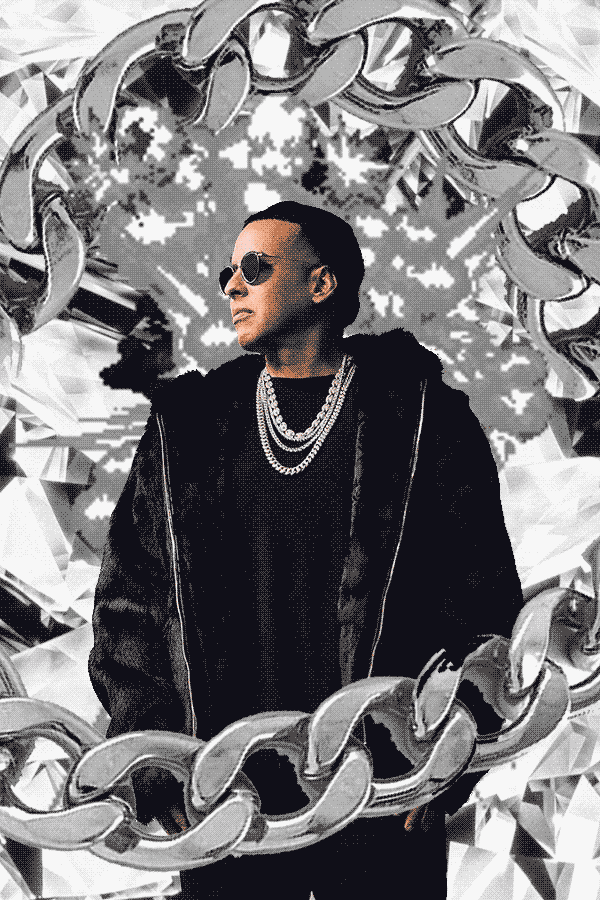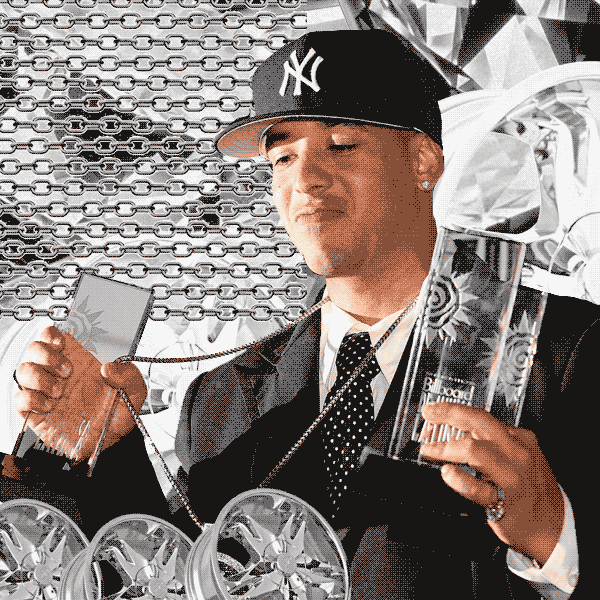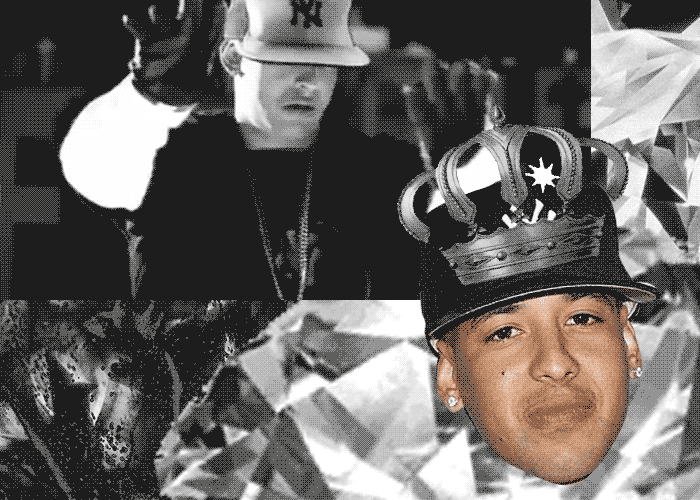Reggaeton began organically as a transformation of dancehall, hip-hop, and reggae en español. As an afro-diasporic movement, Panama, Puerto Rico, Jamaica, the Dominican Republic, and New York are all pivotal landscapes in the style’s musical evolution. Through Tu Pum Pum: The Story of Reggaeton, a column by Eduardo Cepeda, we’ll explore reggaeton’s history, sociopolitical struggles, and its impact as a global force in music and culture.
Daddy Yankee is his own best opener. Last night’s stunning display at Premios Lo Nuestro confirms it.
The first time Yankee performed at Premios Lo Nuestro in 2005, he was something of an oddity – a young, iced-out reggaeton star delivering the gospel of perreo via flying Lambo. This time around, he returned as reggaeton royalty, with everyone aiming to hop on the magic of the dembow riddim that was once so shunned at Spanish-language music awards. For his first performance of the night, Yankee emerged from a giant Baby Yankee head – because why not? And as he delivered a flawless rendition of his latest single “Con Calma,” flanked by dozens of backup dancers, the devoted audience made up of the music industry elite danced in bound devotion.
Then came the lifetime achievement award and tribute performance, in which El Cangri led reggaeton’s vanguard and current generation through a five-song medley highlighting some of his biggest moments, like Barrio Fino‘s “Lo Que Pasó, Pasó” and “Gasolina.” “This is the first time that they’re doing a tribute to an urbano artist at Premios Lo Nuestro, and it’s something that marks the genre’s history,” he told Univision during a rehearsal for this year’s ceremony. As the performance closed, J Balvin echoed this statement. “Without Daddy Yankee, reggaeton wouldn’t exist in the world in the way that it has,” he said, moments after the group (which included Ozuna, Zion y Lennox, Yandel, and De La Ghetto) literally bowed down to reggaeton’s reigning monarch.
It’s not often we’re given the opportunity to see The Big Boss follow his performance of a current hit with an entirely different show made up of 15-year-old anthems, especially ones that defined a generation. The tribute to songs from Barrio Fino, the caserío concept album that swung the door wide open for reggaeton, was particularly impactful.
Daddy Yankee’s third studio album Barrio Fino landed like a genre-cleansing limpia for Spanish-language music. It marked a new beginning, giving certain Latinx audiences – and especially boricuas from the caseríos – a more truthful representation of their lives. And the Puerto Rican rapper delivered with a hauntingly realistic portrait of caserío life. When the album’s first single – the instantly ubiquitous “Gasolina” – landed in 2004, it steadily engulfed airwaves, signaling the major breaking point of a genre 20 years in the making.
Daddy Yankee already commanded respect and admiration as one of reggaeton’s originators (having begun his career as a teenager on 1991’s Playero 34 with the song “So Persigueme/No Te Detengas”), but few could have imagined that Barrio Fino could break reggaeton the way it did. Yet it became the first album of the genre to reach no. 1 on the Billboard Hot Latin charts, and turned Yankee into a global marvel. The album sold over a million copies (making it the highest-selling record by a Latino artist of the decade, and the seventh of all time), and despite relatively minimal airplay at first (it took radio stations some time to catch up with the demand), managed to chart in over 10 countries.

Before the album’s release, the reggaeton scene bubbled with anticipation. Tego Calderón’s 2002 debut El Abayarde set things off by breaking sales records, making a noticeable impact outside of Puerto Rico, even without an initial distribution deal. Then, Luny Tunes’ debut compilation Más Flow introduced an even wider, non-Puerto Rican audience to the sounds of Calderón, Don Omar, and Zion y Lennox, among others. When “Gasolina” dropped, all the dominos aligned.
For many listeners across the globe, Barrio Fino was their first dalliance with reggaeton. For others, it was just the next logical step in the evolution of a sound that had been tinkered with over the years in Panamanian buses, old San Juan nightclubs like The Noise, and in Yankee’s own home studio in the Villa Kennedy housing projects. Barrio Fino emerged directly from his experiences living there, and arrived complete with all the elements of a perfectly well-rounded reggaeton masterpiece. It continued the upward trajectory that 2002’s El Cangri.com had set him on, but delivered a more cohesive experience that touched on a wealth of issues the young genre championed. The album had it all: sex, snapshots of rampant street violence, compelling social commentary, protest poetry, and perhaps most importantly, it fucking slapped.
From the album’s introduction – a poem about the complexities of barrio life, narrated by ex-convict poet Gavilán – Barrio Fino established its tone, noting the different connotations of the word “barrio.” To those inside, it was a badge of honor. But people outside of the caseríos often have classist and racist views of barrios. This early declaration cemented Yankee’s mission statement: not a condemnation of the barrios, nor an exotification meant to sell albums, but rather an honest portrayal of life as he knew it. Much in the same way the gangsta rap of the 90s drew on street stories to spotlight the plight of marginalized communities, Yankee wrote his reality.
As a young rapper, Yankee looked at music as more of a hobby, and aspired to play professional baseball. But during a break from a recording session, a case of mistaken identity led to an AK-47 gunshot wound to his leg, changing his life forever. The bullet ignited a fire in his heart, and drove him to engineer reggaeton’s mainstream breakthrough.

Barrio Fino’s sound includes speaker-rattling marquesina party staples, merengue-driven perreo anthems, and even hip-hop-based explorations into social issues plaguing the island. But the one thing that never wavers is Yankee’s effortless flow – something that his exorbitant fame likely overshadows. As music critic Gary Suarez recently noted, “You’ll never hear Yankee mentioned when people talk about the G.O.A.T.” But make no mistake about it, Daddy Yankee is without question one of the greatest rappers to ever do it; from his rapid-fire delivery on early Playero tapes to his backpacker, boom-bap flow, he’s rarely missed the mark. And Barrio Fino is his lyrical playground.
With “Gasolina” as the anchor single that spread the gospel of reggaeton across the world, Daddy Yankee – and the genre as a whole – quickly entered the global consciousness. Radio stations, nightclubs, and quinceañeras across the world had everyone repeating “gasolina” like they knew what it meant.
And surely, over these last 15 years, someone somewhere lost sleep pondering the meaning of “Gasolina.” Could it be a metaphor for drugs? Sex? Drug-fueled sex? Aside from sharing a name with the Puerto Rican cocktail drink, the reality is far more tame. “It’s one of the most innocent songs I’ve ever written,” Daddy Yankee told Billboard in 2014. The song’s unforgettable refrain (sung by Glory, who wasn’t originally credited on the song) came from listening to women outside his window in Villa Kennedy playfully teasing their friends who accepted rides from men with flashy cars. That’s the whole mystery of it – a song about digging fancy cars.

But it wasn’t just the strength of the lead single that drove the album and Yankee to such great heights. Other singles, and even non-single album tracks, kept the people perreando. “Lo Que Pasó, Pasó” still finds a place in most perreo functions to this day, while “Tu Príncipe” (ft. Zion y Lennox), “No Me Dejes Solo” (ft. Wisin & Yandel), and “Golpe de Estado” (ft. Tommy Viera) helped define the sound of mid-aughts reggaeton.
And a major part of that sound came from crisp production by Luny Tunes, who gave their genre-defining touch to over one-third of the album’s songs, including “Gasolina” and “Lo Que Pasó, Pasó.” As we’ve unpacked before, Luny Tunes’ used innovative production software generally meant for dance music, and coupled with their signature style of blending Caribbean genres like bachata and merengue with dembow, Barrio Fino developed a distinctive sheen.
When Playero 34 dropped in 1991, it must have been impossible to imagine a kid from the Villa Kennedy housing projects on stage 28 years later, showering in praise from an entire industry. And even as Yankee’s career progressed, global admiration probably seemed far-fetched. But Barrio Fino made it possible, and helped launch a once socially maligned genre’s absolute domination.
To this day, El Cangri knows he is who he is because of those modest origins. He knows the barrio shaped him. “Muchas gracias a todos los caseríos de Puerto Rico,” Yankee said as the Premios Lo Nuestro performance came to a close. Coming full-circle 15 years after the formative album’s release, Daddy Yankee still perpetually pays tribute to his own barrio fino.
In lieu of our monthly Tu Pum Pum playlist, stream Barrio Fino below:







